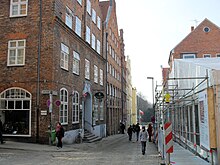Braunstraße (Lübeck)
The Brown Street is a street of Lübeck .
location
The approx. 240 meter long Braunstraße is located in the western central area of the old town island ( Marien Quartier ) and runs in an east-west direction. It begins at the Schüsselbuden , directly opposite the Weiten Krambuden , which leads to the northwest corner of the market , and ends at the Trave , where it joins the An der Untertrave street . At about the height of the second third, Lederstraße turns left as a small cross street to Holstenstraße . It also serves as an entrance to the inner block courtyard (Posthof). A little further down Braunstraße, Einhäuschen Querstraße goes off to the right and thus connects with Fischstraße . The Einhäuschen Querstraße is currently (2010) the starting point for the major excavation in the founding quarter of the Hanseatic city of Lübeck. The cellars of the houses bombed in World War II have already been uncovered under a large tent. The surrounding school buildings from the post-war period are currently being demolished in order to be able to expand the excavations.
history
Braunstraße is one of the oldest streets in Lübeck. It is part of the road network that was laid out when the city was re-established in 1159 and that still provides access to the so-called founding district . It was first mentioned in a document in 1259 as Brunstrate , probably named after a former mayor of the city. The current name has been officially established since 1852.
Until the end of the 19th century , Braunstraße had a closed historical street scene with gabled houses from several centuries. The first interventions took place in the area of the Schüsselbuden with the construction of the post office building there for the parcel post of the Reichspost. But Wilhelminian-style residential and commercial buildings were also built on the waterfront on the Untertrave, not least because of the proximity to the Holstentor . During the air raid on Lübeck on March 29, 1942 , the historic buildings on the middle Braunstraße were completely destroyed with the exception of a few houses at the western and upper ends. During the reconstruction in the 1950s , modern functional buildings were created, so that today neither the appearance nor the spatial impression of Braunstraße corresponds to its historical character. As early as the first phase of the urban renewal, however, sculptural components from the demolished houses began to be integrated into the new buildings, but in some cases elsewhere.
A significant part of the buildings from the post-war years has now been torn down. This was followed by an archaeological investigation of the founding quarter, after which the affected streets are now largely redesigned.
Buildings
- Braunstraße 1–5 , the Reichspost building with an integrated Renaissance sandstone portal by the sculptor Robert Coppens from 1587. It contains a Rococo front door from the mid-18th century. The portal was salvaged from the former Schütting (office) of the shopkeeper in Lübeck, Schüsselbuden 24, when the house was demolished in 1904 and taken over in the neo-Gothic parcel post building of the Reichspost, which was built between 1905 and 1909.
- Former Braunstraße 4 , the demolition of Braunstraße 4 with one of Lübeck's outstanding Renaissance facades was certainly a big loss. The sculptor Statius von Düren produced building sculpture from terracotta in series and had found a capital partner in the wealthy businessman Gerd Reuter . The house at Braunstraße 4, which is richly decorated with terracottas, belonged to this, some authors even suspect a model house of the time. The terracottas were recovered during the demolition and are now in a neo-renaissance building in model lane 3.
- Braunstraße 6 , residential building with Renaissance gable and portal
- Braunstraße 8 , Renaissance gabled house
- Braunstraße 10 , baroque gabled house
- Braunstraße 12 , brick-Gothic gabled house
- Braunstraße 19 , baroque hall house with tail gable and rococo portal and front door
- Braunstraße 23 , Renaissance stepped gable
- Braunstraße 27 , new building at the beginning of the 20th century with an embedded limestone plaque in Gothic minuscule
Portals of Braunstraße
Braunstraße gable
References
See also
literature
- Hartwig Beseler (ed.): Art-Topography Schleswig-Holstein. Wachholtz, Neumünster 1974.
- W. Brehmer : The street names in the city of Lübeck and its suburbs. HG Rathgens, Lübeck 1889.
- Klaus J. Groth : World Heritage Lübeck - Listed Houses. Over 1000 portraits of the listed buildings in the old town. Listed alphabetically by streets. Verlag Schmidt-Römhild, Lübeck 1999, ISBN 3-7950-1231-7 .
- Max Hoffmann: The streets of the city of Lübeck. In: Journal of the Association for Lübeck History and Archeology. Jg. 11, 1909, ISSN 0083-5609 , pp. 215-292 (also as a special print 1909).
- Wilhelm Stier : Lübeck terracottas and Statius von Düren. In: The car . 1958, pp. 44-51.
Web links
Individual evidence
Coordinates: 53 ° 52 ′ 1.4 " N , 10 ° 40 ′ 57.2" E











